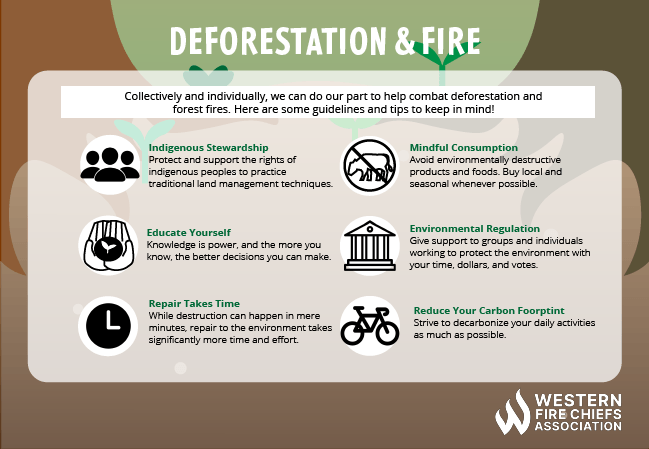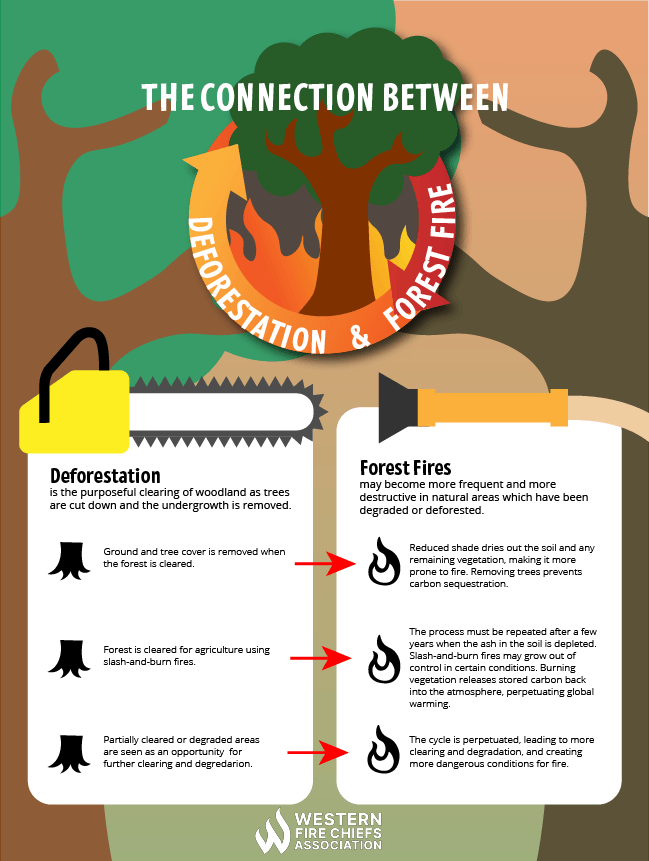Fire Pit Safety Tips
Stay safe around the campfire with tips from the Western Fire Chiefs Association. Learn essential precautions and practices for a worry-free outdoor campfire.
What is the relationship between deforestation and forest fires? Explore this question with expert guidance from the Western Fire Chiefs Association (WFCA).
Published:January 31, 2023
Edited:March 1, 2024

What is the relationship between deforestation and forest fires? Explore this question with expert guidance from the Western Fire Chiefs Association (WFCA).
Images of damaged forests typically show the charred chunks of trees left behind after a fire, and the stumps and clearings after trees are cut down. These two destructive phenomena are linked, according to scientists and researchers. The relationship between cutting down forests and forest fires is demonstrated most clearly in areas of the world with tropical climates that do not typically have forest fires. We are seeing a rise in forest loss throughout the world as increased fires and deforestation move into areas that have not been affected before, especially in the Amazon basin.
Deforestation is the purposeful clearing of woodland as trees are cut down and the undergrowth cleared. This practice has been used throughout history to make space for humans to plant crops and domesticated farm animals to graze for food. Deforestation is also used to gather wood for construction or fuel.1
This practice has been used throughout history and around the world. Europe, North America, and China have seen dramatic decreases in the amount of woodland they once had a few thousand years ago, and tropical rainforests are now being cut down at a rapid rate.1 There have been global reforestation efforts, where trees are replanted in a deforested area, and afforestation, where trees and tree seedlings are introduced to an area that was not forested.2 These efforts take significant amounts of time. Trees grow slowly, and it is difficult to predict how afforestation will affect an ecosystem.
Deforestation contributes to increased fire risk in surrounding woodland. Reducing tree cover and ground vegetation dries out forests, especially tropical rainforests.3 This leads to a greater risk of fire in the area around a deforested zone. Global Forest Watch (GFW) found that, in the past 20 years, fires around the world are increasing annually by 3%, even in areas that have regular fires as part of the ecosystem.4 These fires are becoming more severe and spreading over larger areas than they have in the past.
Fire is sometimes a part of the deforestation process. Slash-and-burn agriculture is a method of deforestation. Farmers burn forested land, which adds ash to the soil. This rich soil can help crops grow for a few years before the process is repeated in a new area.1 Slash-and-burn agriculture has been practiced globally for over 7,000 years and can be performed sustainably on a small scale by native populations who rely on slash-and-burn to grow food.5 However, the practice negatively impacts air quality, increases greenhouse gas emissions, and decreases local biodiversity. It takes decades for soil and trees to recover and for birds and mammals to return to land cleared by slash-and-burn methods.
Depending on weather conditions, slash-and-burn fires can get out of control and cause widespread wildfire damage. The smoke from these fires can affect weather patterns to reduce rainfall, which creates droughts and more fire-prone conditions in surviving forests.3
When fires are used to deforest areas that do not have fire as part of the natural lifecycle, such as tropical rainforests, this can have a severe effect on the region and species that are unfamiliar and unprepared to respond to wildfires. Introducing fire in these areas alters the weather and dries out plants that thrive in humidity, which increases forest fire risk.6

Climate change affects the health and growth of trees. Major temperature fluctuations, shifting weather patterns, and droughts or floods can affect how quickly an area is restored from deforestation.2 There is increasing interest in reforestation and afforestation, and increasing opposition to deforestation as governments and the public have seen its impact on the environment.
Trees take in carbon dioxide as part of photosynthesis, converting this greenhouse gas from the atmosphere and converting it into biomass. This process is called carbon sequestration.7 Because of the ability of trees to store huge amounts of carbon dioxide, forest fires release the stored carbon. In turn, forest fires are responsible for one-quarter of all fire-related carbon dioxide emissions each year, even though forests are only 10% of the land affected by annual fires.8 Fewer trees absorbing and sequestering carbon means that carbon dioxide builds up in the atmosphere.1
In effect, this creates a cycle of deforestation generating carbon dioxide and reducing sources that take in this greenhouse gas. Even with reforestation and afforestation efforts, carbon sequestration is a slow process, taking years as trees grow and mature. Deforestation creates conditions that make it difficult to sustainably regrow forests.
The Amazon rainforest covers 1.4 billion acres and spans eight South American countries: Brazil, Bolivia, Peru, Ecuador, Colombia, Venezuela, Guyana, and Suriname. It holds roughly 40% of Earth’s remaining tropical forest. Millions of species of plants, animals, and insects live in the Amazon basin, along with over 30 million humans.9
The climate of the region is warm and wet. Fire is not a part of the rainforest’s natural cycle, but the agricultural and cattle industries use fire to clear large areas of the Amazon.6 This deforestation, combined with climate change’s effect on rainfall and temperature, increases the chance of new wildfires.10
Even forest fires that are not human-created are sometimes used as a deforestation opportunity. A recent study examined the decrease in the Amazon rainforest between 2013-2020 and found that, on average, only 11% of the area affected by fire is deforested within three years. This indicates that fire is not usually a first step towards removing vegetation in the Amazon, but the study did see a high probability that human-caused deforestation will take place within a few years of a wildfire.6
Brazil has seen fires and fire-related air pollution rise as deforestation efforts increased since the 2000s. The Brazilian government worked to protect large sections of the Brazilian Amazon and saw deforestation drop.3 However, in the past 10 years, many protection policies that were put in place during the mid-2000s are not being enforced. Deforestation is increasing again. In 2019, fires affected between 1,640-4,000 square miles of Amazon forest. The impact on biodiversity that year was comparable to 2009 when regulations limiting deforestation were enforced.10 Approximately 85% of the 2019 fires were directly beside areas that had been deforested the year before. The decrease in tree cover reduced moisture and humidity in the forest and increased the temperature and wind speeds in the area.11 This leaves the area more prone to future forest fires.
The effect of deforestation can be permanent in some areas, but conservation efforts to manage natural resources and reduce the effect humans have on the environment can help forests regrow and thrive.1 Government regulations and strict enforcement policies are a major step in protecting forested land. Researchers also cite indigenous land-management practices as important guidelines for managing natural resources.6 Ultimately, while deforestation is quick, rebuilding the ecosystem and reducing the increased fire risk associated with deforestation takes time, patience, and care.
Stay safe around the campfire with tips from the Western Fire Chiefs Association. Learn essential precautions and practices for a worry-free outdoor campfire.
Discover essential firework safety tips to ensure a dazzling display without accidents. Learn how to celebrate responsibly with expert guidance from WFCA.
Explore the role of AI in wildfire prediction with guidance from the WFCA. Learn how advanced algorithms and data analytics enhance early detection and response.